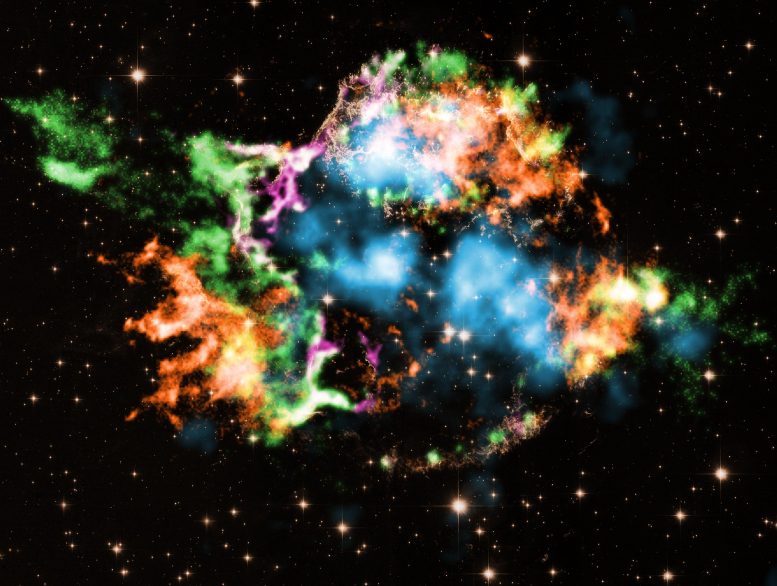
Astronomers using NASA’s Chandra X-ray Observatory have announced the discovery of an important type of titanium blasting out from the center of the supernova remnant Cassiopeia A (Cas A), a result that could be a major advance in understanding how some massive stars explode. The different colors presented in these images mostly represent elements detected by Chandra in Cas A: iron (orange), oxygen (purple), and the amount of silicon compared to magnesium (green). Titanium (light blue) detected previously by NASA’s NuSTAR telescope is shown, but not the different type of titanium found by Chandra. These X-ray data have been overlaid on an optical-light image from the Hubble Space Telescope. Credit: Chandra: NASA/CXC/RIKEN/T. Sato et al.; NuSTAR: NASA/NuSTAR; Hubble: NASA/STScI
- Astronomers used Chandra to detect an important type of titanium in the supernova remnant Cas A.
- This titanium is predicted to form in bubbles that drive the explosion of a massive star after its fuel is depleted and it implodes.
- The detection of such titanium provides strong support for a class of supernova explosion studied in computer simulations.
- The result uses 18 days of Chandra observing time of Cas A taken between 2000 and 2018.
Astronomers using NASA’s Chandra X-ray Observatory have announced the discovery of an important type of titanium, along with other elements, blasting out from the center of the supernova remnant Cassiopeia A (Cas A). This new result could be a major step for understanding exactly how some of the most massive stars explode.
The different colors in this new image mostly represent elements detected by Chandra in Cas A: iron (orange), oxygen (purple), and the amount of silicon compared to magnesium (green). Titanium (light blue) detected previously by NASA’s NuSTAR telescope at higher X-ray energies is also shown. These Chandra and NuSTAR X-ray data have been overlaid on an optical-light image from the Hubble Space Telescope (yellow).
When the nuclear power source of a massive star runs out, the center collapses under gravity and forms either a dense stellar core called a neutron star or, less often, a black hole. When a neutron star is created, the inside of the collapsing massive star bounces off the surface of the stellar core, reversing the implosion.
The heat from this cataclysmic event produces a shock wave — similar to a sonic boom from a supersonic jet — that races outwards through the rest of the doomed star, producing new elements by nuclear reactions as it goes. However, in many computer models of this process, energy is quickly lost and the shock wave’s journey outwards stalls, preventing the supernova explosion.
Recent three-dimensional computer simulations suggest that neutrinos — very low mass subatomic particles — made in the creation of the neutron star drive bubbles that speed away from the center of the explosion. These bubbles continue driving the shock wave forward to trigger the supernova explosion.
This new Chandra study reports that finger-shaped structures pointing away from the explosion site, to the lower right, contain titanium and chromium, coinciding with the iron debris seen in orange. The titanium found by Chandra is a stable isotope of the element, meaning that the number of neutrons its atoms contain implies that it does not change by radioactivity into a different, lighter element. The titanium previously detected in Cas A with NuSTAR is an unstable isotope, which transforms over a timescale of about 60 years into scandium then calcium. The stable titanium isotope found by Chandra is not shown in the figure.
The conditions required for the creation of the chromium and stable titanium in nuclear reactions, such as the temperature and density, match those of bubbles in three-dimensional simulations that drive the explosions.
This new study strongly supports the idea of a neutrino-driven explosion to explain at least some supernovas.
Cas A is located in our galaxy about 11,000 light years from Earth, and it is one of the youngest known supernova remnants, with an age of about 350 years. Astronomers used over a million and half seconds, or over 18 days, of Chandra observing time from Cas A taken between 2000 and 2018 to conduct this research.
A paper describing these results appears in the April 22, 2021 issue of the journal Nature. The authors of this paper are Toshiki Sato (Rikkyo University in Japan), Keiichi Maeda (Kyoto University in Japan), Shigehiro Nagataki (RIKEN Cluster for Pioneering Research in Japan), Takashi Yoshida (Kyoto University), Brian Grefenstette (California Institute of Technology in Pasadena), Brian J. Williams (NASA Goddard Space Flight Center in Greenbelt, Md.), Hideyuki Umeda (University of Toyko), Masaomi Ono (RIKEN Cluster for Pioneering Research in Japan ), Jack Hughes (Rutgers University in Piscataway, NJ).
Reference: “High-entropy ejecta plumes in Cassiopeia A from neutrino-driven convection” by Toshiki Sato, Keiichi Maeda, Shigehiro Nagataki, Takashi Yoshida, Brian Grefenstette, Brian J. Williams, Hideyuki Umeda, Masaomi Ono and John P. Hughes, 21 April 2021, Nature.
DOI: 10.1038/s41586-021-03391-9
NASA’s Marshall Space Flight Center manages the Chandra program. The Smithsonian Astrophysical Observatory’s Chandra X-ray Center controls science from Cambridge Massachusetts and flight operations from Burlington, Massachusetts.



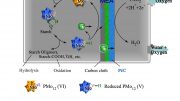
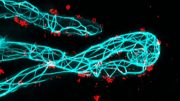
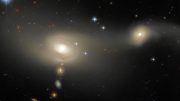


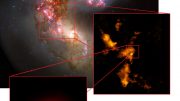
Be the first to comment on "How Do the Most Massive Stars Explode? Bubbles With Titanium Trigger Titanic Explosions"